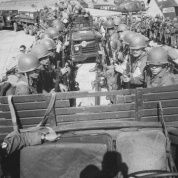On 28 April, the United States government deployed 42,000 troops to occupy the Dominican Republic.

The country had experienced 30 years of one of the most brutal dictatorships in Latin American history, led by Rafael Leonidas Trujillo.
After a the dictator was killed in 1961, democratic elections were held.
It is estimated that, during Trujillo's reign of terror, 25,000 people were killed or disappeared by the State.
Trujillo was a member of the U.S.-founded and trained National Guard. The U.S. government backed his dictatorship until the end.
Juan Bosch, a political activist, intellectual and writer, launched his presidential campaign after 23 years living in exile. Bosch had been jailed by Trujillo in 1933, and fled the country in 1938.
Most of his time in exile, he spent it in Spain, Cuba and Puerto Rico, with several visits throughout Latin America, where he actively spoke against Trujillo's brutal dictatorship.
Bosch, who was a progressive, held a strong friendship with other regional leaders such Cuba's Fidel Castro, Costa Rica's Jose Figueres and Venezuela's Romulo Betancourt.
Bosch, Figueres and Betancourt were all victims of assassination plots orchestrated by Trujillo.
In the 1962 elections, Juan Bosch swept in, winning the presidency and a majority in parliament. Soon the democratically elected president began to make profound changes in the country.
By April 1963, a new constitution was drafted, meant to incorporate social rights and to impede dictatorships in the future. Bosch had also began to implement a land reform.
In September 1963, a coup – headed by General Elias Wessin y Wessin – ousted the president, after only 7 months in power. The coup was backed by the CIA. Bosch fled the country.
Wessin y Wessin was a key general for the late Trujillo and had helped most of his collaborators flee the country after the tyrant's assassination in 1961.
By April 1965, a broad pro-democratic movement which included sectors of the army demanded the return to 1963's Constitution and the restoration of Bosch as president.
After a military rebellion, they were able to oust the military junta.
The defeated Wessin y Wessin- led junta used their influence over key army officers to launch air attacks and tried to regain the presidential palace. The battles evolved into a chaotic urban war.
The anti-Bosch generals allied with the U.S. government and requested help. This led to a U.S. military invasion, in order to prevent Bosch from returning to the presidency.
After the invasion, a provisional government was set up and elections – under U.S. occupation – resulted in the rise to power of Joaquin Balaguer, one of Trujillo's closest aides.
The politician had tried to inherit power from Trujillo after his death, but different political movements forced him to resign as head of the provisional government in 1962.
Balaguer installed a 'civil' dictatorship, resulting in hundreds of disappearances and deaths of political foes.
During his 12 year dictatorship, Balaguer installed several paramilitary forces (or death squads) to eliminate the growing left-wing movements in the country.
By the end of his dictatorship, it is calculated that around 5,000 people were killed or disappeared by the State.
RELATED: 1965 Revolution Shaped Resistance in Dominican Republic and US